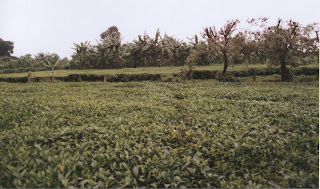 Eating Out
Eating OutRestaurants, cafes, motels and hotels offer all things appetizing.
Local Cuisine!
Another fantastic experience was tasting the local cuisine. The best (in our opinion) are the SAMOSAS! A samosa is a triangle shaped pastry filled with seasoned ground beef or vegetables. They are considered a snack, but you can eat them for breakfast, lunch or dinner. We ate them whenever we could. Whoever wants to know we have the recipe. We even made some for family during Thanksgiving and they loved them!
 Other popular dishes are: rice and beef stew, mũkimũ (irio) (potatoes mashed with a variation of peas,corn, beans, collard greens), fish and ugali (like gritz or white cornbread), chapati (similar to tortilla) and ndengũ (lentils), nyama choma (grilled meat) with kachumbari (like pico de gallo), Matoke ( stewed potatoe and green banana/plantain), Sweet potatoes and arrow roots. Mandazi ( donut like but square,oblong or triangular), meat pies. Oh we could go on forever!
Other popular dishes are: rice and beef stew, mũkimũ (irio) (potatoes mashed with a variation of peas,corn, beans, collard greens), fish and ugali (like gritz or white cornbread), chapati (similar to tortilla) and ndengũ (lentils), nyama choma (grilled meat) with kachumbari (like pico de gallo), Matoke ( stewed potatoe and green banana/plantain), Sweet potatoes and arrow roots. Mandazi ( donut like but square,oblong or triangular), meat pies. Oh we could go on forever!Fruits and Vegetables
In the garden
There are plenty of fresh fruits and vegetables. Mangoes, Oranges, Pawpaw, Passion Fruit, Pineapple, Avacado, Apples and more. Ask anyone, fruit from the tropics, simply Delicious!
 An assortment of vegetables: Cabbage, Carrots, Sukuma Wiki (Colored greens),Spinach, Parsley, (Dania (Coriander), Celery, Cucumber, Tomotoes and more.
An assortment of vegetables: Cabbage, Carrots, Sukuma Wiki (Colored greens),Spinach, Parsley, (Dania (Coriander), Celery, Cucumber, Tomotoes and more.In the Supermarket
Supermarkets offer whatever your heart desires: See what we found;

Cookies (Biscuits)
Local Drinks
Tea or Coffee
You will find an assortment of drinks everywhere you go. Coffee & Tea are very popular!
Tea is drunk with milk and sugar, usually hot, very hot! Should you visit a home or someone in an office, expect them to offer you Tea, Coffee or hot Chocolate(Cocoa).
Tea drinking is a local tradition and is served about 10.00 a.m and 4.00 p.m. We always had our tea as soon as we got back from town. This was usually before dinner. Coffee is fast becoming popular and you will find coffee shops in all corners of major cities.
 Soda or Juice
Soda or Juice
Tea is drunk with milk and sugar, usually hot, very hot! Should you visit a home or someone in an office, expect them to offer you Tea, Coffee or hot Chocolate(Cocoa).
Tea drinking is a local tradition and is served about 10.00 a.m and 4.00 p.m. We always had our tea as soon as we got back from town. This was usually before dinner. Coffee is fast becoming popular and you will find coffee shops in all corners of major cities.
 Soda or Juice
Soda or Juice Water
You can find bottled water at most hotels, restaurants and supermarkets.
Coming next: Planning your safari- 5 EASY STEPS
For more, email us: mysafari@wrightsafaris.com

















